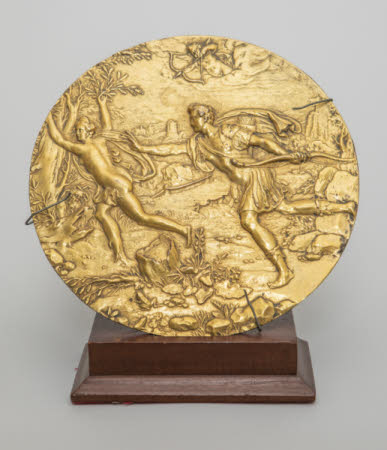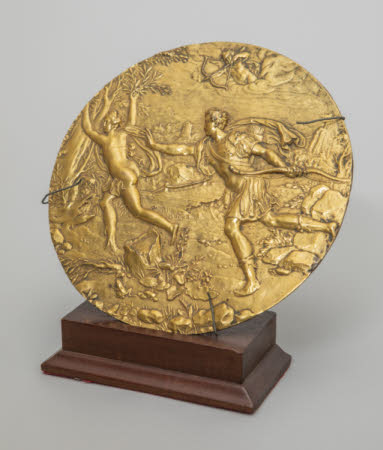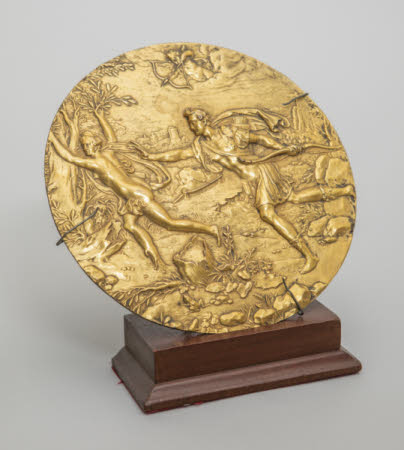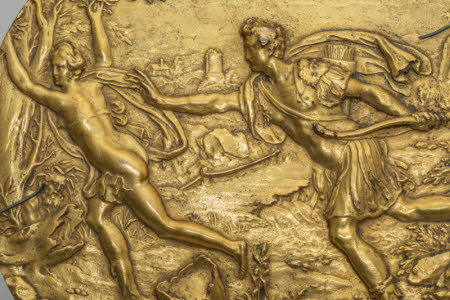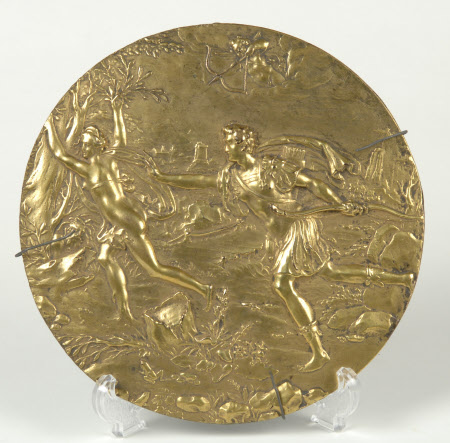Apollo and Daphne
workshop of Paulus Willemsz van Vianen (Utrecht c.1570 - Prague 1613)
Category
Art / Sculpture
Date
c. 1600 - 1620
Materials
Gilt bronze
Measurements
197 mm (7 ¾ in) Diameter
Place of origin
Prague
Order this imageCollection
Kingston Lacy Estate, Dorset
NT 1255222.3
Summary
Sculpture, gilt-bronze; Apollo and Daphne; Paulus van Vianen (c. 1570-1613) and workshop; c. 1600-1620. One of a set of four gilt-bronze roundels featuring scenes from the Roman poet Ovid’s Metamorphoses, designed by the Utrecht-born silversmith Paulus van Vianen. Part of a series of at least twelve designs, which would have been used in objects made from silver such as shallow dishes (tazze), but were also reproduced in bronze and in lead. The four plaquettes now at Kingston Lacy possibly come from the large group of Netherlandish and German plaquettes recorded in the collection of King Charles I, in his Cabinet Room at Whitehall Palace, in 1638 or 1639.
Full description
A gilded bronze roundel depicting Apollo and Daphne. Within an extensive landscape appear the figure of Daphne, naked except for a flimsy drape that billows out as she runs, pursued by the god Apollo, dressed in all’antica armour and holding a bow in his left hand, his right hand reaching out towards the girl. Branches and leaves are beginning to spring out from her hands, as she is turned into a laurel tree. The front surface is entirely gilded. Part of a series of four similar reliefs (1255222.1-4). Daphne was a nymph, the daughter of the river god Peneus, and the victim in one of the great tragic love stories in mythology, recounted by Ovid in his Metamorphoses (I, 450-568). Cupid shot a gold-tipped arrow at the sun god Apollo, who on seeing Daphne fell violently in love with her. However, Cupid had also shot at Daphne an arrow, but this one was tipped with lead, which had the opposite effect of causing love to take flight. Daphne thus became a cool and pure virgin, who ranged through the woods hunting and avoiding the company of men, despite her father urging her to marry. As soon as Apollo saw her, he fell violently in love with the beautiful nymph, who fled his advances until, too exhausted to go any further, she prayed to her father for deliverance. At once, branches began to grow from her arms and roots from her feet, as she became transformed into a laurel tree. The theme became especially popular with artists in the 17th and 18th centuries. As in Paulus van Vianen’s relief, most chose to depict the dramatic scene when Apollo, on the point of finally catching Daphne, saw her transformed before his eyes into the laurel tree. The most celebrated treatment of the theme in sculpture is Gian Lorenzo Bernini’s masterpiece in marble in the Borghese Gallery in Rome, completed in 1625. The four gilt-bronze circular reliefs at Kingston Lacy all illustrate episodes from the Roman poet Ovid’s long poem ‘Metamorphoses’, which became a very popular source for artists, composers and writers from the Renaissance period onwards. All the stories in the Metamorphoses concern transformations of gods and other individuals in mythology. The set at Kingston Lacy is just part of a larger series of at least twelve large circular plaques with episodes from the Metamorphoses. The larger series included four scenes from the story of Jupiter, Juno and Io (see 1255222.2 and 4) and another four from the story of the sun god Phoebus and the death of his son Phaethon. Finally, two scenes from the story of Jupiter, Juno and Callisto survive, as well as the two from the story of Apollo, Cupid and the nymph Daphne. It is possible that other lost scenes from these stories once existed. For discussion of the series and the attribution to Paulus van Vianen, see NT 1255222.1. All the plaquettes are extremely rare, most surviving in just one or two examples in bronze or in lead, and a couple only known through documentary references. The only other currently known version of the Apollo and Daphne is in the Rijksmuseum, Amsterdam, in lead. However, this design was influential and was used in adapted form in a number of works by Netherlandish silversmiths working later in the seventeenth century, notably on a large dish in the Frisian Museum, Leeuwarden (Frederiks 1952, no. 183) by Rintie Jans (fl. 1646 – after 1673), which copies other designs in Paulus van Vianen’s Metamorphoses series. The design is also used as the centrepiece of a silver baby-linen basket in the Wallace Collection, London (Inv. W163; ter Molen 1980), made by the Deventer silversmith Lucas Luicksen (fl.1652-1677). The design was also used in considerably modified form in a wax roundel, larger in size than the original plaquette, in the Victoria & Albert Museum, London (Inv. A.17-1928). Jeremy Warren May 2023
Provenance
First recorded In the 1860 inventory drawn up by Rosa Louisa Bankes (1827-1878); bydescent; bequeathed by (Henry John) Ralph Bankes (1902-1981), together with the estates of Corfe Castle and Kingston Lacy and its entire contents
Makers and roles
workshop of Paulus Willemsz van Vianen (Utrecht c.1570 - Prague 1613) , sculptor after Paulus Willemsz van Vianen (Utrecht c.1570 - Prague 1613) , original artist
References
Amsterdam 1952: Catalogus van Goud en Zilverwerken, benevens zilveren, loden en bronzen Plaquetten, Rijksmuseum Amsterdam, 1952, no. 439. Frederiks 1952: J.W. Frederiks, Dutch Silver. I. Embossed Plaquettes, Tazze and Dishes from the Renaissance until the end of the eighteenth century, The Hague 1952, no.86, CC. Weber 1975: Ingrid Weber, Deutsche, Niederländische und Französische Renaissanceplaketten 1500-1650, 2 vols., Munich 1975, no.948.7, Taf.268. Ter Molen 1980: J. R. ter Molen,‘Een zilveren luiermand in de Wallace Collection’, Nederlands Kunsthistorisch Jaarboek, Vol. Vol. 31 (1980), pp. 204-214 Ter Molen 1984: J.R. ter Molen, ‚Van Vianen: een Utrechtse familie van zilversmeden met een internationale faam‘, PhD Dissertation, 2 vols., Leiderdorp 1984, no. 131. Warren 2014: Jeremy Warren, Medieval and Renaissance Sculpture in the Ashmolean Museum, 3 vols., Oxford 2014, nos. 477-81.
